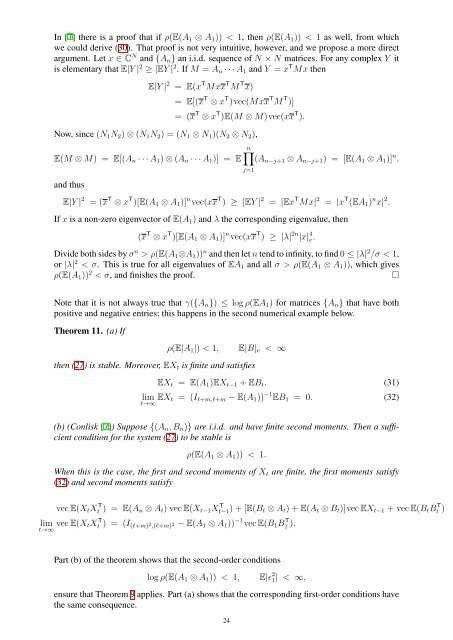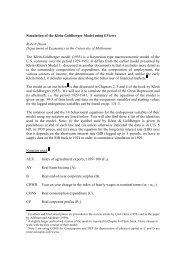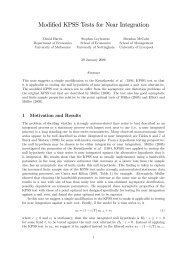Cobweb Theorems with production lags and price forecasting
Cobweb Theorems with production lags and price forecasting
Cobweb Theorems with production lags and price forecasting
Create successful ePaper yourself
Turn your PDF publications into a flip-book with our unique Google optimized e-Paper software.
In [7] there is a proof that if ρ(E(A1 ⊗ A1)) < 1, then ρ(E(A1)) < 1 as well, from which<br />
we could derive (30). That proof is not very intuitive, however, <strong>and</strong> we propose a more direct<br />
argument. Let x ∈ C N <strong>and</strong> {An} an i.i.d. sequence of N × N matrices. For any complex Y it<br />
is elementary that E|Y | 2 ≥ |EY | 2 . If M = An · · · A1 <strong>and</strong> Y = x T Mx then<br />
E|Y | 2 = E(x T Mxx T M T x)<br />
= E[(x T ⊗ x T )vec(Mxx T M T )]<br />
= (x T ⊗ x T )E(M ⊗ M)vec(xx T ).<br />
Now, since (N1N2) ⊗ (N1N2) = (N1 ⊗ N1)(N2 ⊗ N2),<br />
E(M ⊗ M) = E[(An · · · A1) ⊗ (An · · · A1)] = E<br />
<strong>and</strong> thus<br />
n�<br />
(An−j+1 ⊗ An−j+1) = [E(A1 ⊗ A1)] n ,<br />
E|Y | 2 = (x T ⊗ x T )[E(A1 ⊗ A1)] n vec(xx T ) ≥ |EY | 2 = |Ex T Mx| 2 = |x T (EA1) n x| 2 .<br />
If x is a non-zero eigenvector of E(A1) <strong>and</strong> λ the corresponding eigenvalue, then<br />
j=1<br />
(x T ⊗ x T )[E(A1 ⊗ A1)] n vec(xx T ) ≥ |λ| 2n |x| 4 e.<br />
Divide both sides by σ n > ρ(E(A1⊗A1)) n <strong>and</strong> then let n tend to infinity, to find 0 ≤ |λ| 2 /σ < 1,<br />
or |λ| 2 < σ. This is true for all eigenvalues of EA1 <strong>and</strong> all σ > ρ(E(A1 ⊗ A1)), which gives<br />
ρ(E(A1)) 2 < σ, <strong>and</strong> finishes the proof. �<br />
Note that it is not always true that γ({An}) ≤ log ρ(EA1) for matrices {An} that have both<br />
positive <strong>and</strong> negative entries; this happens in the second numerical example below.<br />
Theorem 11. (a) If<br />
ρ(E|A1|) < 1, E|B|e < ∞<br />
then (27) is stable. Moreover, EXt is finite <strong>and</strong> satisfies<br />
EXt = E(A1)EXt−1 + EBt. (31)<br />
lim<br />
t→∞ EXt = (Iℓ+m,ℓ+m − E(A1)) −1 EB1 = 0. (32)<br />
(b) (Conlisk [7]) Suppose {(An, Bn)} are i.i.d. <strong>and</strong> have finite second moments. Then a sufficient<br />
condition for the system (27) to be stable is<br />
ρ(E(A1 ⊗ A1)) < 1.<br />
When this is the case, the first <strong>and</strong> second moments of Xt are finite, the first moments satisfy<br />
(32) <strong>and</strong> second moments satisfy<br />
vec E(XtX T t ) = E(An ⊗ At) vec E(Xt−1X T t−1) + [E(Bt ⊗ At) + E(At ⊗ Bt)]vec EXt−1 + vec E(BtB T t )<br />
lim<br />
t→∞ vec E(XtX T t ) = (I (ℓ+m) 2 ,(ℓ+m) 2 − E(A1 ⊗ A1)) −1 vec E(B1B T 1 ).<br />
Part (b) of the theorem shows that the second-order conditions<br />
log ρ(E(A1 ⊗ A1)) < 1, E|ɛ 2 1| < ∞,<br />
ensure that Theorem 9 applies. Part (a) shows that the corresponding first-order conditions have<br />
the same consequence.<br />
24







